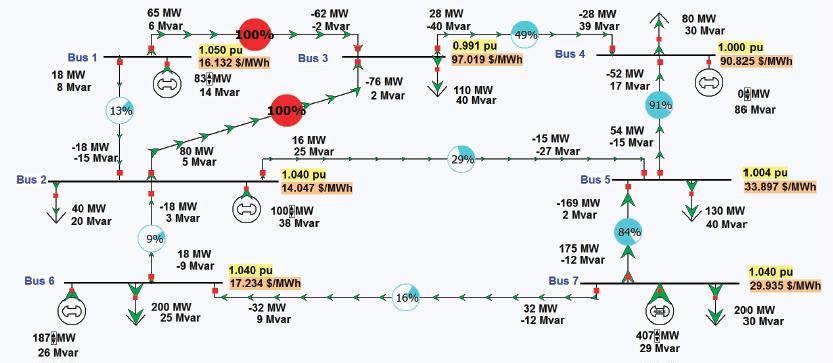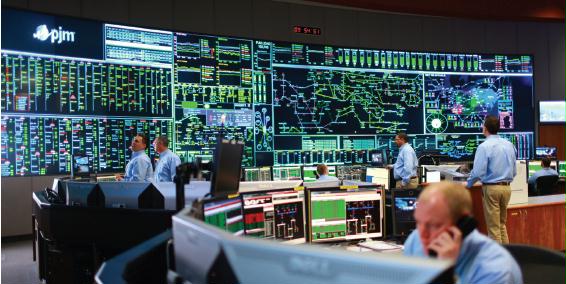The U.S. electric grid produces 64% of electricity in 2019 with finite fossil fuels, and another 20% from nuclear power. Since fossil fuels and uranium are finite, and biomass doesn’t scale up, the electric grid needs to evolve to 100% renewables from the 9% of renewables powering the U.S. grid today, with the majority of the new power from wind and solar, since sites for hydropower (and pumped), geothermal, utility scale batteries, and Compressed Air energy storage are limited.

Electrical math problem solution of original seven-bus system
with generator at bus 4 ~
Click the image to enlarge
If supply and demand aren’t kept in exact balance, the grid can crash. So increasing penetration of wind and solar will make the grid less stable since they are unreliable, variable, and intermittent. Power engineers need to solve this increasing instability.
Plus completely redesign the grid, which now is mainly a “one-way” grid where power flows from about 6,000 very large, centralized power plants and existing systems can keep good track of it. As millions of home and industrial solar panels and wind turbine farms push electricity the “wrong way” increase, the potential for a blackout grows, because this power is invisible to the operators who keep supply and demand in balance.
Distribution grids around the world tend to operate in relative darkness, in terms of lacking sensors and monitors to reveal their point-to-point and moment-to-moment condition to grid operators. That will have to change as distributed energy resources take up an increasing role. Solar PV in particular can cause problems on distribution systems designed for one-way power flows by causing voltage disruptions or tripping protective equipment. Electric vehicle chargers can add significant loads to circuits not designed to handle them, as can electrifying loads that now run on fossil fuels. To manage this shift, network investments will need to increase substantially over the next decade, covering not only traditional grid reinforcement but also “smart solutions,” such as demand-side flexibility (Deign 2020).

Control center room ~ Click the image to enlarge
New models, new algorithms, new mathematics, and higher-powered computers than we have now will be needed to be invented to cope with tens of millions of future rooftop solar panels, wind turbines, machinery and appliances, energy storage devices, automated distribution networks, smart metering systems, and phasor measurement units (PMUs) sending trillions of bits of data every few seconds.
This paper proposes that new institutes staffed with power and other engineers be created. Which is easier said than done. Solar panels and wind turbines may be “sexy”, but becoming a power engineer isn’t. Anyone smart enough to become a power engineer can make far more money in other fields, which is why most universities have dropped their power engineering department.
This can be seen in the coming expertise crisis — for every two electric sector employees about to retire, the industry has less than one to replace them (the nuclear power sector alone needs 90,000 trained workers and engineers soon). A lack of specialized workers to maintain and operate the infrastructure will greatly impact affordable, reliable service since new employees don’t have a lifetime of knowledge. They’re bound to make catastrophic errors, which will increase rates for consumers and blackouts (Makansi 2007, NAERC 2006).
Renewable power needs genius engineers to also solve these issues:
- The electric grid is interdependent on other systems (transportation, water, natural gas and more). These systems also need to be modeled to make sure there is no impact on them as the grid evolves.
- As wind and solar grow, placing new unpredictable demands on the grid, better forecasting tools are needed.
- Better climate change forecasting tools are also needed since climate change will introduce several uncertainties affecting the grid. In addition to higher temperatures requiring increased air conditioning loads during peak hours, shifting rainfall patterns may affect the generation of hydroelectricity and the availability of cooling water for generating plants. The frequency of intense weather events may increase.
- Modeling and mitigation of high-impact events such as coordinated physical or cyberattack; pandemics; high-altitude electromagnetic pulses; and large-scale geomagnetic disturbances, and so on are especially difficult because few very serious cases have been experienced. Outages from such events could affect tens of millions of people for months.
This report anticipated the need to create fake data in order to hide real data from terrorists that might enable them to find weak points and how/where to attack them. Well oops, too late! The Russian attack of up to 18,000 government and private networks via SolarWind likely snagged the Black start plans of how to restore the electric grid after a cataclysmic blackout. The plans would give Russia a hit list of systems to target to keep power from being restored in an attack like the one it pulled off in Ukraine in 2015, shutting off power for six hours in the dead of winter. Moscow long ago implanted malware in the American electric grid, and the United States has done the same to Russia as a deterrent (Sanger et al 2021).
Understanding this report and the problems that need to be solved requires a power engineering degree and calculus, so I only listed a few of the most simple-to-understand problems above, and excerpted what I could understand. Some of these issues are more understandably explained in the Pacific Northwest National Laboratory paper: “The Emerging Interdependence of the Electric Power Grid and Information and Communication Technology.”
After reading this 160 page report I felt like the magnitude of the data from billions of sensors and energy producing and consuming devices every few seconds needed to balance the grid and filtered down to simple visual images and alarms a human operator could comprehend was like making the electric grid conscious.
|
ABOUT THE AUTHOR
Alice Friedemann (www.energyskeptic.com) is the author of “Life After Fossil Fuels: A Reality Check on Alternative Energy”, 2021, Springer; “When Trucks Stop Running: Energy and the Future of Transportation”, 2015, Springer, Barriers to Making Algal Biofuels, and “Crunch! Whole Grain Artisan Chips and Crackers”. Podcasts: Collapse Chronicles, Derrick Jensen, Practical Prepping, KunstlerCast 253, KunstlerCast278, Peak Prosperity , XX2 report.
|